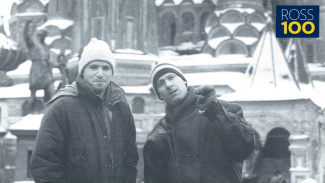The History of MAP at Michigan Ross

The Multidisciplinary Action Projects course has been the cornerstone of action-based learning at the Ross School of Business for the past 32 years. Through this program, students participate in a full-time project taking on real-world business challenges for a sponsor company or nonprofit organization.
While initially conceived as a signature component of the Full-Time MBA curriculum, MAP has grown, expanded, and evolved to become a required course in all Full-Time, Part-Time, Executive, and Global MBA Programs at Michigan Ross. In more recent years, the program has even expanded into the BBA and One-Year Master’s Programs. Today, nearly every Ross student has the opportunity to participate in MAP or a similar course.
The early beginnings of MAP
The concept of MAP was first considered in 1991 when the pilot program with four student projects was launched. The program was officially adopted in 1992, and that year, students completed 21 projects focused on businesses in the region of Southeastern Michigan, the majority of which were automotive.
However, the program presented a challenge to the curriculum structure at the business school. At the time, the school only offered 14-week, semester-long courses. To accommodate the new, 7-week program, Dean Joe White and Associate Dean Paul Danos changed the MBA annual schedule to four half semesters. Five faculty members were asked to forego their Winter B core courses and assignments to become the first faculty group to teach and advise MAP teams.
“The placement of MAP as a half-term project course in the Winter B half semester, equaling the credit of five existing half-semester core courses, was viewed as innovative, disruptive, and surprising to many in the Michigan Business School community when announced in 1991,” said Andrew Lawlor, lecturer of entrepreneurship and lecturer of strategy at Michigan Ross.
In order to facilitate the program, a faculty task force was formed to plan the transition from the five separate core courses in Winter B to a single MAP course. Those faculty members from operations management, management accounting, management and organizations, statistics, and business communications who were asked to teach and advise the first MAP cohort created an achievable and successful MAP course plan with specific definitions, scopes of work, and challenges to be offered to teams of four to six MBA1 students.
At the time of its launch, Associate Dean Danos described MAP as a “breakthrough course” in the Fall 1991 Dividend magazine. “It creates a new way of integrating disciplines around a topic every corporation must come to grips with – that is, to ensure that these processes work effectively,” he said. “The course creates teams, forces students to deal with a real business, and teaches operations at the nitty-gritty level. It complements the high-level strategy our students are exposed to in much of the curriculum.”
In the same issue of Dividend, Dean White commented on the new MAP Program:
We are giving students real-world experience in an unprecedented way, and we are providing services to help students become complete business leaders. We are also building in continuous development for the program itself so that we retain our traditional strengths and at the same time continuously invent tomorrow’s business education.
MAP in its second decade
In 2002, Dean Bob Dolan assembled a new task force to assess the 10-year-old MAP processes and results and to recommend changes and enhancements to take MAP to a new level. Starting in 2003, strategy, marketing, and finance faculty were added to the MAP faculty advisor group, and the project content was likewise expanded to cover those areas.
A few years later, Dean Dolan created the Office of Action-Based Learning to manage the full, year-round MAP processes of sponsor development, proposal management, course leadership, logistics, and execution. He merged the International MAP course (launched in 1995) and the Entrepreneurial MAP course (launched in 2002) with the Domestic MAP course to create today's expanded full-time MAP experience.
Modern-day MAP at Michigan Ross
Since the 1991 pilot program, MAP has become a foundational part of the curriculum at Michigan Ross, persevering even through the COVID-19 pandemic, albeit in a temporary virtual format. More than 16,000 students have enrolled in the MAP Program, traveling to 98 countries and completing over 3,349 projects.
A core theme of the program has been its mutually beneficial nature, positively impacting student career outcomes while providing value to sponsor companies – enough that many sponsors come back year after year. Additionally, Michigan Ross alums tend to be some of the biggest advocates for sponsoring MAP projects in their companies, helping expand the program’s reach.
Today, MAP partners with companies and organizations across industries and around the globe. Since the 2017 academic year, Microsoft has sponsored the most projects at 45, followed by Amazon at 35. Other notable sponsors include Google, Ford Motor Co., General Motors, Fidelity, Gulfstream Aerospace, and Aravind Eyecare System.
“A lot has changed in terms of how we support MAP, how the advising is set up, and the organizations we work with,” said Chris Tarnaki, managing director of the Office of Action-Based Learning at Michigan Ross. “But at the end of the day, it's always been a project, and it's always been students’ primary focus for one-eighth of their degree.”







